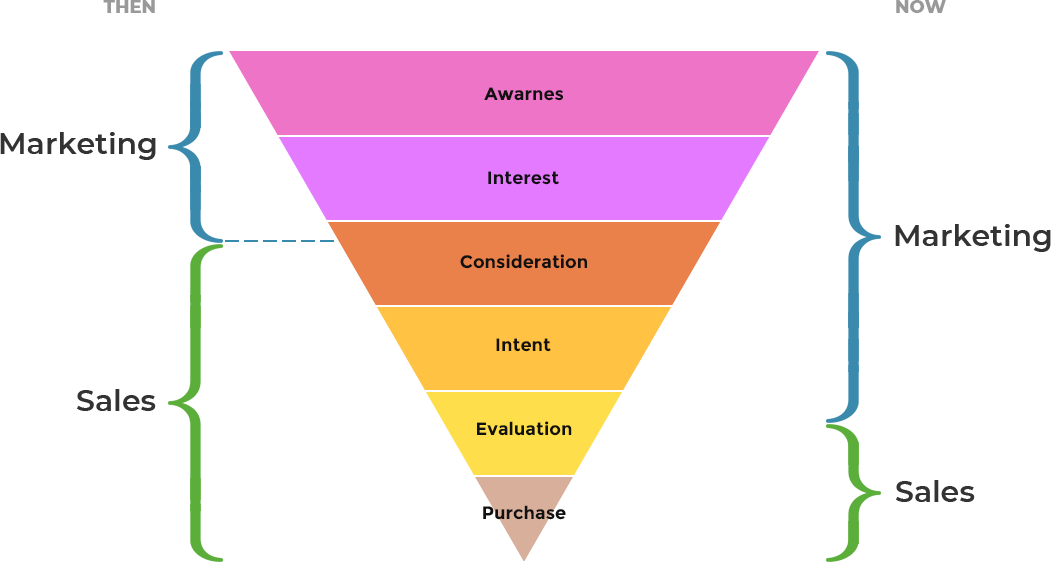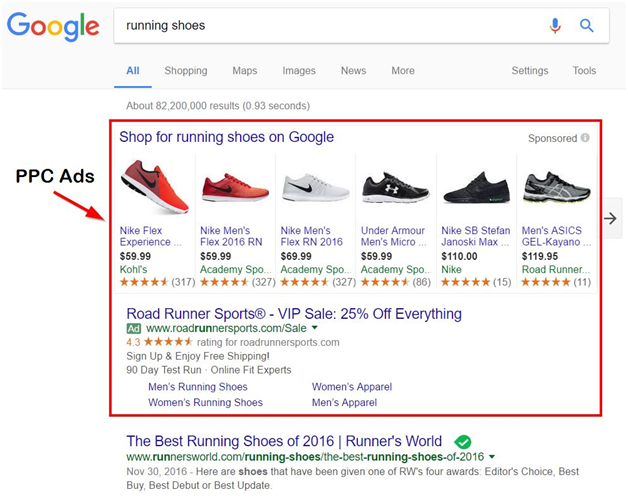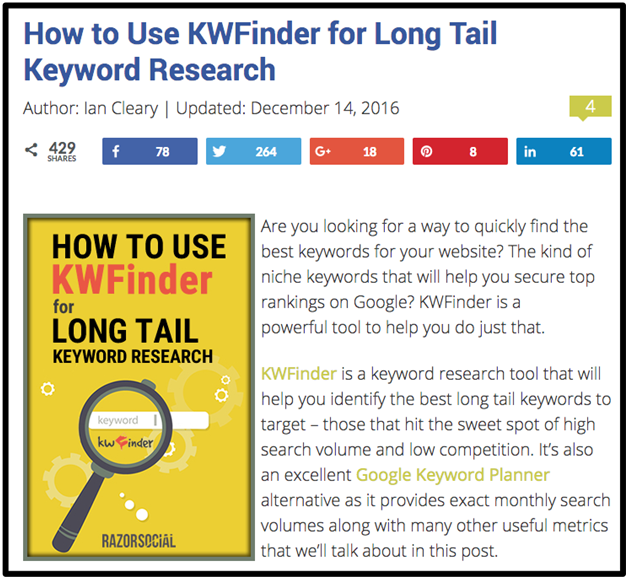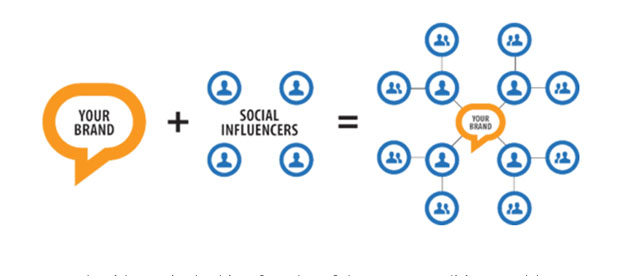Content marketing has gotten loads of publicity in the last few years. Despite being nearly as old as the human race (think cave paintings), it’s only recently been labeled and taken advantage of.
Why?
Because people focused on other marketing tactics. Tactics that, frankly, no longer work.
We’re talking, of course, about interruptive marketing – commercials, flashy banner ads, and annoying, in-your-face pop ups telling you to “Click Here Now!!” (not that you shouldn’t use pop ups, just not the traditional kind).
Humans have evolved.
The average consumer today is far more informed than the average consumer 30 years ago. Thanks to the internet, we now have access to more free information, and can spot slimy sales tactics and lies more easily than ever before.
The verdict is in: 84% of millennials don’t trust traditional advertising.
In fact, the modern-day sales funnel now looks like this:
The New Marketing & Sales Funnel

People don’t trust salespeople to give them the right information. Instead, we do all of our research online before we ever pick up the phone or visit a store. We just want salespeople to act as cashiers – or to help us decide between two very close choices.
That’s where content marketing comes in – it can help you win the trust of your customers, give them the information they’re searching for during their research, and help sway them to purchase your product over the competition.
Oh, and the cherry on top: It’s almost fool-proof. According to HubSpot, 82% of marketers who blog see positive ROI from their inbound marketing. Are you convinced yet?
Now, here’s what we’ll talk about in this guide:
- What is Content Marketing?
- What Do You Need to Get Started with Content Marketing?
- Cost
- Time
- Employees
- The Types of Content Media
- Paid Media
- Earned Media
- Owned Media
- Shared Media
- Tips for Huge Content Marketing Success
Are you ready to learn how to use Content Marketing for your business? Let’s dive in.
1. What is Content Marketing?
Before you can use content marketing, you have to understand what it is. At its core:
Content marketing is the act of creating and promoting content in order to drive traffic, leads, and sales to a business.
Great definition, but what does that actually look like?
Well, “owned media” content can come in the form of:
- A company blog
- A podcast
- A YouTube channel or video content
- User-generated content (such as reviews, case studies, or visual content)
- Webinars
- Whitepapers and ebooks
On the other side of the content marketing coin, you have:
- Paid media
- Earned media
- Shared media
This guide will dive into the different types of content and media promotion, and how you can embrace each. But before that, there is one more crucial question…
2. What Do You Need to Get Started with Content Marketing?
As business owners, we always want to know: What’s the cost?
Of course, cost doesn’t just mean money –other resources include time, energy, and human capital (i.e. employees/contractors).
This section seeks to answer the following questions:
- How much does it cost to start a successful content marketing program?
- What kind of time investment is needed?
- Will I need to hire someone to help me?
Let’s find out.
How much does it cost to start a successful content marketing program?
The beauty of content marketing?
It’s completely possible to succeed with a marketing budget of $0.
In fact, according to DemandMetric, content marketing costs 62% less than traditional marketing and generates about 3 times as many leads.
That said, there are two strategies (which can be combined for maximum effect):
- Spend no money, but invest a lot of time on outreach and promotion.
- Spend a lot of money on advertising, with little time spent on outreach and promotion.
Of course, you’ll always have to spend at least some time on outreach and promotion, regardless of how much money you spend (unless you hire someone to do it for you). We recommend combining the two, if your budget allows, as this will give you the best possible results.
You can spend as much or as little on paid content distribution as you want. It all depends on your budget. We’d say a monthly budget of $2000 is a good place to start, if you really want to put a hard number on it.
What kind of time investment is needed?
The process of content marketing looks like this:
- Get published (meaning, secure some press coverage, write a blog post of your own, shoot a video, or record a podcast).
- Include content upgrades – and other premium downloadable assets, gated behind optin forms – so as to capture and nurture leads.
- Promote that content (if done properly, this should take you just as much time as it took you to get the content published, i.e. two hours spent writing means at least two hours spent promoting).
- Work with influencers and media outlets to enhance the reach and authority of your content.
- Measure engagement (via analytics tools) and get feedback from your readers (via a newsletter, social media, blog comments, etc.).
- Use those signals to produce better content.
- Continue to nourish your leads by sending relevant, valuable emails and staying top-of-mind.
So how much time does a full-fledged content marketing strategy take to execute? Depending on the business sphere you’re operating in and how quickly you’re looking to attract an audience, likely dozens of hours each week.
Budgets and human resources can vary a lot from company to company, but in our experience, a good recommended minimum volume to aim for is three earned media placements and two owned media items – plus distribution.
If you’re after rapid growth, turning to an agency can help a great deal with content creation, PR, getting eyes on the content, and more; which leads to the third question…
Will I need to hire someone to help me with content marketing?
Launching your first major content marketing initiative can seem overwhelming. It may seem easier to hire someone to help you with it (and it often is).
The short answer: No, you don’t need to hire someone. Given that no one knows your business as well as you do, you might even be better off handling it all yourself.
It’s completely possible to launch a content marketing initiative all on your own. We know of several people who started as an incredible team of one, and used content marketing to grow their businesses from zero to six figures and beyond, entirely by themselves.
That said, hiring a professional service can make the job much easier – and more effective.
Obviously, in order to get active in content marketing, you have to actually get published. This requires creating your own content, working with influencers, and earning PR coverage. If you don’t have a strong network of connections that have audiences, if you’re not a good writer or if you’re camera-shy, creating content can prove difficult, no matter how many guides you read.
While over time you can get over your fear of cameras and become a better writer, it’s quicker (and often easier) to hire someone to create content, secure earned media, and promote the content for you. Hiring a B2B content marketing agency, or a freelance expert, allows you to accomplish more with your content faster – and skip the trial and error learning phase entirely.
You can find great writers by posting to a job board like ProBlogger, browsing writers on UpWork, or hiring independent freelancers.
According to CMI, 86% of highly effective organizations have someone in charge of content strategy. Ultimately, however, the decision comes down to how much money you have to spend versus how much time you have to commit.
Moving right along…
3. The Different Types of Content Media
Content marketing is multi-faceted. There are many different types and branches to explore as you learn the craft.
We’ve categorized all the types of content into four media types: Paid, Earned, Owned, and Shared. I’ll explain what each of these means in their respective sections.
Media Convergence Drives Content Stack Evolution

Paid Media
Paid media, as the name implies, refers to all the ways you can pay to promote your content or have content published on your behalf on someone else’s platform (such sponsored articles, or video ads, for example).
In this section, I’ll explain each type of paid media and point you to a resource to learn more.>
Pay-Per-Click (PPC)
PPC advertising means you pay every time someone clicks on your ad. You’ve certainly seen them on Google.

Types of PPC include:
- Search advertising (Such as Google AdWords)
- Social media advertising
- Display ads (including those on “native content promotion” networks such as Outbrain)
- Remarketing (while the above three bullets refer to PPC placement types, remarketing refers to an extremely effective PPC targeting method)
PPC advertising can be daunting to tackle for the first time. There’s a lot that goes into it, from keyword research and understanding your customer to analyzing results and tweaking your campaigns.
However, the results can be lucrative when done right. According to WordStream, for high commercial intent searches (someone looking to buy a product), paid ads get 65% of all clicks. Additionally, Unbounce found that PPC visitors are 50% more likely to purchase something than organic visitors.
If you’re ready to dive into the world of PPC, WordStream wrote this excellent beginner’s guide.
Paid Influencers
Influencer marketing is the process of getting influential people (typically with large and highly engaged followings, such as celebrities or industry thought leaders) to share your content, increasing its reach.
You’ve probably seen it before in your social media feed. Here’s an example of Jeff Bullas promoting an article by Content Creator:
140 Characters Aren’t Enough: 5 Visuals You Should Tweet https://t.co/WB4KRYVth7 #sponsored by @contentcreatora pic.twitter.com/qmwtFA2zrs
— Jeff Bullas (@jeffbullas) January 19, 2017
This type of marketing is a major form of promotion (both paid and unpaid), well-known for its role within content marketing. Why?
According to TapInfluence, influencer marketing content delivers 11X higher ROI than traditional forms of digital marketing. Additionally, 49% of people say they rely on recommendations from influencers when making purchase decisions.
People trust influencers more than they trust businesses they’ve never worked with.
Of course, not all influencer marketing is paid marketing, but we have a section in shared media on unpaid influencer marketing.
If you’re going to pay an influencer, they had better be able to show you an ROI.
Many influencers will do wonders for you, and all you have to do in return is give them a backlink and some shares. When money is involved, that’s when ROI really starts to matter.
When it comes to finding paid influencers, it’s pretty similar to finding influencers in general. Look for thought-leaders within your industry (using a tool like BuzzSumo or NinjaOutreach) and begin to build relationships with them prior to pitching them.
When you do reach out to them, say something like this:
“Hello [their name],
I love your work and all the great things you’ve done for the [your industry] industry. I see you share a lot of content in that space, as well.
I work with [your company] and I was wondering if you might be interested in receiving payment in exchange for promoting our brand to your audience. If you’re interested, we can work out the details.
Either way, keep up the excellent work, and I look forward to speaking with you again soon! 🙂
Cheers,
[Your Name]”
It’s really that simple! For more help on influencer marketing, check out this guide by TapInfluence.
Pro Tip: For best results from influencer marketing campaigns, try teaming up with an agency. They can build the relationships for you (and often work with many influencers already).
Earned Media
The second type of content media is earned media, which can include PR features, mentions, platforms, and audiences which you’ve earned through hard work, but do not own.
Types of earned media include:
Mentions, Feature Articles, and PR
Any time your brand is mentioned (such as being tagged in a social media post), featured in an article, or receives any kind of public relations publicity (such as a mention in the news), that’s earned media.
For example, the KWfinder tool was recently covered in a full article featuring them on the RazorSocial blog. While they may not have pitched the author, Ian Cleary, to land this post, having an excellent tool is what “earned” them this great press – Cleary’s audience doesn’t know whether KWfinder has been in touch with him or not, and they probably don’t care either way!

Now, you don’t own those channels, but you still benefit from the increased authority, traffic, and backlinks they provide.
- Increased authority, because people will associate your name and brand with the website you’re featured on or mentioned by. When a brand discusses its own products in a favorable light, people might or might not take it at face value, but an impartial thought leader’s words in a trusted publication? That’s powerful.
- Increased traffic, because readers are likely to click through to your platform, and when they do so from a content asset that recommends that they use your products, we’re talking about a high likelihood that these referred audience members intend to actually do so. Many will open accounts with you or opt in as leads, so you can follow up with them and nurture relationships that can eventually lead to sales.
- Increased backlinks (meaning, links from one site back to yours), because they’ll be linking to you from the article when they feature you. This will also boost your search engine rankings!
Getting more of these types of mentions is partly luck, partly hard work and networking. So yes, you can do it yourself… but, if you want to see real results quickly in a way you can easily scale, you should consider using a top-rated agency.
For some tips on getting more mentions, check out HubSpot’s 11 ideas to grow brand awareness.
SEO
Search Engine Optimization (SEO) is the act of optimizing your content in the hopes of ranking higher on search engines. Typically, this means:
- Performing keyword research using tools like Google Keyword Planner, SEMrush, Moz, or the SEO Power Suite.
- Performing on-page SEO for your content.
- Building backlinks from highly authoritative sites to the pages you want to rank.
Of course, there are many other factors that go into ranking your website on Google and beyond, but the above steps cover the basics of SEO.
The benefit of ranking highly on Google is huge: Loads of highly targeted traffic. One study found that the top ranking position on Google gets as much as 33% of all search traffic!

If you’re ready to tackle SEO, check out Moz’s complete beginner’s guide.
Reposts and Syndication
Content syndication is the process of sending your content to other third-parties, who will then republish it on their own sites.
“What?!” I hear you saying, “Why would I want to do that? That content is mine!”
Because, dear content marketer, you can piggyback on larger sites’ authority, traffic, and search engine rankings.
You see, whenever your content is reposted on another site, as long as they use proper canonical tags (more on that later), the “link juice” (SEO speak for the power of a website’s links to you to help you rank) will be passed onto you.
Sujan Patel, one of the world’s leading digital marketers, does this often by reposting his content from his blog and guest posts to his LinkedIn pulse account:

If you want to learn more about content syndication, canonical tags, and link juice, check out this piece by Search Engine Journal.
Reviews
Reviews from customers (known as “user-generated content”), are amazing for your business. They provide social proof and word-of-mouth referrals, and build brand awareness and trust with your audience.
I place them under earned, rather than owned, media because, despite being on the website you own (unless they’re on Amazon or something), they must still be earned. You can’t simply place a fake user review on your site. (Well, you can, but that’s morally wrong and downright stupid – people often catch on to such shenanigans.)
Here are five tips to help you get more customer reviews.
Owned Media
Owned media refers to the media completely under your control. While it has many benefits (which we’ll discuss briefly), it also has a few drawbacks compared to owned media, such as increased difficulty of driving traffic. However, what’s the best thing about owned media?
It gives you the greatest amount of control over your content and your audience.
In addition, it’s more trackable, gives you the ability to retarget your audiences, allows you to build your own funnels to convert leads, and gives you full control over branding.
Shared media has a volatility problem known as “digital sharecropping.” You can develop a huge social media following, then one day Facebook can reduce the amount of followers who see your content – and there’s nothing you can do about it.
With owned media, you have the control. You won’t lose your audience because some CEO somewhere thought it was a good idea.
Now then, on to the types of owned content media:
Your Website & Blog
Your website is like your sanctuary. You can change the drapes or remodel any time you like. Feel like rehauling the entire thing? You can do that too.
Your blog, then, is like the hallway to each room in your sanctuary (your blog posts). Some of your posts may be like a powder room (only a few hundred words) and others like a grand hall (several thousands words which act as your hub page).
Of course, this is where the magic happens. Content marketing is centered around your blog. The bigger, better, and more knowledge-rich your posts, the greater chance you have of increasing traffic, building backlinks, ranking on Google, and capturing leads to increase sales.
For successful content marketing via an owned blog, you must:
- Create amazing, bookmark-worthy content.
- Promote that content until your eyes bleed.
- Use audience signals to create even better content.
- Rinse and repeat.
However, content marketing wouldn’t be complete without…
Your Email List
Your email list is worth its weight in gold. It’s the one medium that you own where you can instantly reach all of your followers at any time, without paying to have it “boosted.”

In fact…
- You are 6 times more likely to get a click-through from an email campaign than you are from a tweet.
- Email subscribers are 3 times more likely to share your content via social media than visitors from other sources.
- Email is 40 times more effective in referring new customers than social giants like Facebook or Twitter.
Convinced yet? Capturing emails is one of the major goals of content marketing.
Emails will help you keep your audience engaged with your content and increase conversions of your readers into customers.
Some tips for capturing more emails:
- Offer a content upgrade on your blog posts.
- Use a tool like SumoMe or OptinMonster to offer popups or welcome mats to capture leads.
- Once you capture a lead, keep them engaged with relevant, valuable emails.
- Give users multiple ways to sign up (i.e. a newsletter, content upgrade, inline optin, exit-intent popup, etc.)
Check out KISSmetric’s 10 tips to capture more email leads.
Shared Media
Shared media is the last type of media we’ll be talking about, but it certainly isn’t the least in terms of importance. It refers to shared content, word of mouth, referrals, community-driven content, and co-creation.
The three types of shared media I’m about to “share” with you (pun completely intended) will be essential to building your website’s content
strategy.
Here we go:
Social Media Engagement

Social media continues to be a crucial element of content marketing – I’ve mentioned it in three of the four types of media! This time, rather than talking about shares or mentions, I’m talking specifically about in engagement – i.e. how much your followers interact with you or your brand.
Yes, shares and mentions are engagement. But, more specifically, we’re talking about comments and messages. How much are your followers trying to talk with you?
As I’ve stated before, customer feedback is crucial to content marketing success. After all, the whole purpose of your content is to help your prospects and customers! By participating in the conversations going on about your brand, you’re able to do more of what works and cut what doesn’t.
Shares
Social shares have many benefits, such as increased traffic, brand awareness, and possibly even search engine ranking. Plus, seeing a large number of shares on something you wrote just can help you to validate the path you’re on.

If you’re wondering how to get more shares, Neil Patel shares his favorite eight tactics on the QuickSprout blog.
Keep in mind, however, that shares aren’t enough. You need to look at your analytics data to see what that social traffic is doing (and whether the shares are even getting you traffic at all!)
Guest Posting
Guest posting is an excellent addition to any content marketing strategy. However, there can be some confusion as to why…
Why would you want to spend precious resources writing for someone else?
- Backlinks to your own content for an SEO boost.
- Borrow their traffic to bring to your own site.
- Be seen as an authority in your industry by appearing on industry-leading blogs.
Don’t take our word for it – Jeff Goins, one of the most well-known online bloggers, says guest posting helped him build relationships, rank on search engines, and meet new people.
Here are some tips for finding, landing, and getting the most out of guest posts:
- Pick three or four high-quality blogs you want to guest post for. They should have high domain authority (search their site on Moz OSE), high engagement (blog comments and social engagement) and a large following.
- Start building a relationship with the decision-makers. According to Hunter, identifying the right person to contact is one of the most essential steps of guest posting. Follow them on Twitter, comment on their blog, share their posts, and try to genuinely befriend them.
- Once you’ve given tons of value, reach out to them. Send them an email telling them how much you love their work, how you’d really like to write for them, and some pieces you’ve previously written. Be sure to propose a few headlines based on what their audience would like.
- Write an incredible post. Just as you wouldn’t skimp on quality with your own posts, don’t skimp on theirs, either.
- Continue to nourish that relationship. Respond to post comments, continue to interact with the owner on social media, and be friendly. Internet marketing is all about relationships, after all!
Unpaid Influencer Marketing
I’ve already shown you the benefits of influencer marketing in the paid section above. Unpaid influencer marketing can be just as lucrative (perhaps even more so, because it’s built on relationships rather than money).

When identifying relevant influencers to work with, you’re looking for a lot of the same qualities as a blog to guest post on:
- Not necessarily a large following, but a highly engaged one (high average retweets, lots of comments, lots of link clicks).
- High domain authority (again, search their site in Moz OSE).
- Same industry as yours, but not a competitor.
An excellent resource to learn more about influencer marketing is Jason Quey’s ultimate guide to influencer marketing on the SumoMe blog.
4. Final Tips for Huge Content Marketing Success
We covered a lot in this guide, and we don’t want to give you information overload. However, there are a few parting tips we’d like to give you to ensure you get the most out of your content marketing strategy:
- Be consistent. Work to continually appear in top publications and in the social feeds on the pages of your select influencers. Post fresh content of your own on the same time/day every week (no less than one post per month).
- Provide tons of value (aka teach, don’t sell). When writing content, you want to keep your ideal reader in mind. What are their pain points that you can solve with your content? How can you make your content just a little bit better (i.e. more imagery, resources, or action steps)? Always go the extra mile.
- Build relationships. Internet marketing, and content marketing, gets easier and more efficient as you develop more and deeper relationships. You’ll find those you interact with start to share and link to your content without even having to ask them, and they’ll begin to look to you as an influencer and authority in your industry.
- Share, then share some more. Just because you shared something once, doesn’t mean you can’t share it again. CoSchedule recommends you share your content many times over the course of days, weeks, months, and even years.
- Be a growth hacker. Growth hacking is the art of finding unique (and typically free and highly efficient) ways to acquire users and market your content. Think sharing on forums like Reddit, doing a crazy dance video in the middle of a mall and watching it go viral, or finding niche sites to advertise on that are very cheap with a huge ROI.
5.Conclusion
Content marketing is one of the most efficient and effective ways of marketing your business in an age where commercials appear every 20 seconds and ad blockers are installed on nearly 77% of computers.
People don’t want to be interrupted by advertising. Instead, they want to be entertained, informed, and moved. They want stories that make them laugh, cry, or get inspired.
Content marketing is the vehicle for delivering those stories. If we listen to Seth Godin, content marketing is the only real marketing left.
We hope you learned as much reading this post as we did preparing it. Be sure to bookmark it so you have a resource to come back to, and please share it if you found it helpful!
What are your biggest content marketing struggles? Let us know in the comments below!
Suspendi Nunc umsan dit tellus
Suspendisse vehicula at arcu at sollicitudin integer laoreet orci tellus eget vulputate neque. congue r consequat
Download